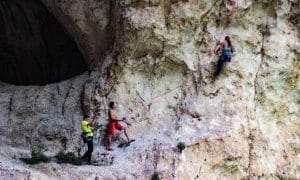Bouldering and rock climbing have exploded – can cannabis help with this hot activity?
Even 5 years ago, rock climbing and bouldering were niche activities for those with a passion. But since it has become a fun, core strengthening, urban activity and is now a multi-billion dollar industry. Cities, towns and cruise ships now have climbing gyms and the popularity as soared. North American climbing gyms alone almost reached $1 billion dollars last year, this doesn’t count outdoor, equipment and other markets. With its popularity, it blends in with other lifestyle options, so here are key tips on bouldering and marijuana.
RELATED: Marijuana And Exercise, All Part Of The Healthy Cannabis Life
France is was the birthplace of modern bouldering. Pierre Allain, a pioneering French climber in the mid-20th century, loved the Fontainebleau forest and was among the first to see bouldering as a unique discipline within climbing, not just a training tool. He developed climbing shoes with rubber soles, increasing climbers’ ability to grip the rock, a revolution which helped bouldering gain recognition as a legitimate sport. Around the same time in the US, a gymnast as well as a climber, John Gill approached bouldering with a focus on strength, balance, and dynamic movement. Regarded as the father of modern bouldering, he introduce the concept ‘clean climbing’ – leaving no trace on the rock – which has influenced generations of climbers to respect and protect the natural environment.

A Climbing Magazine anonymous survey of professional climbers a couple years ago, in which most said they used it for recovery while others said they sometimes climbed while using cannabis. A deeply-researched review conducted by scientists, including members of the World Anti-Doping Agency and National Institute on Drug Abuse, found that “the use of cannabis as doping will not help to gain a competitive edge by any means.” But the review also highlighted how cannabis can help athletes deal with anxiety in high-pressure situations—climbing includes plenty of high-pressure situations—and “play a major role in the extinction of fear memories” from traumatic athletic events, such as suffering a tough whipper or something more serious.
RELATED: Science: Cannabis Does Not Make You Lazy After All
“Cannabis improves sleep and recovery after an event, reduces anxiety and fear and aids the forgetting of negative events such as bad falls and so forth,” researchers wrote. “Cannabis enhances sensory perception, decreases respiratory rate and increases heart rate; increased bronchodilation may improve oxygenation of the tissues.”

Marijuana can also help you in the gym during training sessions. A University of Colorado study concluded using marijuana before exercise “increases motivation” as well as “enhances recovery from exercise.” Recovery is huge, particularly in sports brutal on the body like climbing. Professional athletes in football, basketball, hockey, fighting, and even golf have all come out in favor of using cannabis as a recovery tool, with some saying CBD is enough.
RELATED: How To Use CBD For A Better Night’s Sleep
More than those other sports, though, safety is of the utmost importance while climbing. Combining marijuana and climbing should be done with serious intention and without harming belay partners or fellow climbers. An online survey conducted by Training Beta, a website dedicated to rock climbing training, explored how readers felt about the relationship between climbing and cannabis. Among 1,462 respondents, 47% said they weren’t comfortable with high belayers and 46% responded that it depended on the setting and person belaying them.
- SEO Powered Content & PR Distribution. Get Amplified Today.
- PlatoData.Network Vertical Generative Ai. Empower Yourself. Access Here.
- PlatoAiStream. Web3 Intelligence. Knowledge Amplified. Access Here.
- PlatoESG. Carbon, CleanTech, Energy, Environment, Solar, Waste Management. Access Here.
- PlatoHealth. Biotech and Clinical Trials Intelligence. Access Here.
- Source: https://thefreshtoast.com/cannabis/key-tips-on-bouldering-and-marijuana/#utm_source=rss&utm_medium=rss&utm_campaign=key-tips-on-bouldering-and-marijuana



